Instructions to Candidates
- Write your name and index number in the spaces provided above.
- Sign and write the date of examination in the spaces provided above.
- Answer all the questions in the spaces provided.
- This paper consists of 8 printed pages
- Candidates should check the question paper to ascertain that all the pages are printed as indicated and that no questions are missing.
FOR EXAMINER’S USE ONLY
|
Questions 1- 24 |
Maximum score |
Candidates score |
|
80 |

QUESTIONS
- Name the cell organelles which are abundant in (2 mks)
Muscle cells-
Pancreas – - Explain why the fine adjustment knob is used only when using high power objective lens. (1 mk)
- Distinguish between osmotic pressure and osmotic potential. (2mks)
- Describe two adaptations of a leaf to the process of photosynthesis. (2mks)
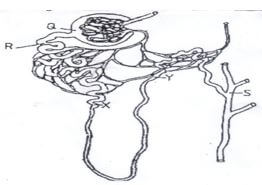
The diagram below illustrates part of a nephron from a mammalian kidney.- Name the fluid in the part labelled Q. (1mk)
- Identity the process responsible for the formation of the fluid named in (a) above. (1mk)
- Which two hormones exert their effect in the nephron? (1mk)
-
- The figure below illustrates a portion of a chromosome with genes named A, B, C, S, Q and R.
Use the diagrams similar to the ones above to illustrate the changes if the above chromosome undergoes the following mutations affecting only gene C and S.A
B
C
S
Q
R
- Deletion. (1mk)
- Inversion. (1mk)
- Human-inherited features can be grouped under two headings as follows.
Group A Group B Weight, intelligence, height tongue rolling, blood group, eye Color. - What is the genetic explanation for the difference between the two groups? (2mks)
- The figure below illustrates a portion of a chromosome with genes named A, B, C, S, Q and R.
-
- Calculate the respiratory quotient of the oxidation reaction below. (2mks)
2C51H98O6 + 145O2 → 102CO2 + 98H2O + Energy - Name the possible food being oxidised. (1 mk)
- Calculate the respiratory quotient of the oxidation reaction below. (2mks)
- The wings of a bird and that of insects are analogous structures.
- What are analogous structures? (1 mark)
- Name this type of evolution. (1 mark)
- Name two vestigial structures found in man. (2 marks
-
- The diagram below represent the structure of a nerve cells.

- Identify the nerve cell. (1 mark)
- Give a reason for your answer in a (i) above. (1 mark)
- State the function of part labelled T. (1 mark)
- Using an arrow show the direction of an impulse on the diagram. (1 mark)
- The diagram below represent the structure of a nerve cells.
- The diagram below represents a bone of a mammal.
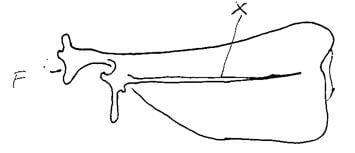
- Identify the bone? (1 mark)
- Name the part marked X. (1 mark)
- Name the bone that articulates at the part labelled F. (1 mark)
- State two adaptations of the bone to its function. (2 marks)
- The diagram below shows a phenomenon which occurs during cell division.
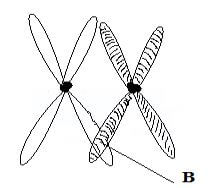
- Identify the stage of cell division in which this phenomenon occurs. (1 mark)
- State the importance of the phenomenon taking place in the part labeled B. (2 marks)
- Mutiso is unable to read history textbook held at arm’s length but read clearly at normal length.
- Identify the defect he is suffering from. (1 mark)
- Why was he unable to read the book clearly at arm length? (1 mark)
- How can the defect be corrected? (1 mark)
- State two functions of blood in a human body. (2 marks)
- State 3 significance of water in seed germination. (3 marks)
- State two differences between complete and incomplete metamorphosis. (2 marks)
- The diagram below represents a fern.
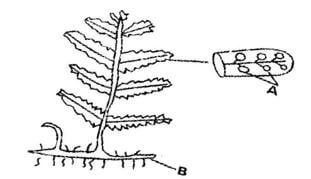
- Name Parts labeled A and B. (2mk)
A –
B – - To which division does the plant belong? (1mk)
- Name Parts labeled A and B. (2mk)
-
- Define the term immunity. (1mk)
- Distinguish between natural immunity and acquired immunity. (2mks)
- Identify one immunizable disease in Kenya. (1mk)
- The diagram below shows a stage during fertilization in flowering plant.
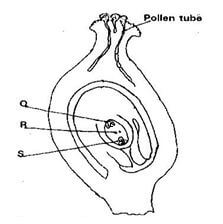
- Name the parts labeled Q, R, and S. (3 mks)
Q –
R –
S – - State the function of the pollen tube. (1mk)
- Name the parts labeled Q, R, and S. (3 mks)
-
- State the major cause of the ‘Global warming’ experienced in the world today.(1mk)
- Suggest two ways of reducing the Global warming. (2mks)
- An experiment was set to investigate a certain aspect of response. A seedling was put on a horizontal position as shown in figure M below. After 24 hours, the set up was as shown in figure N.
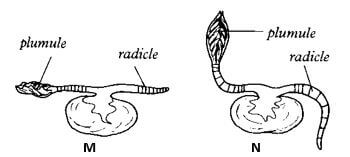
- Name the response exhibited. (1mk)
- Explain the curvature of the shoot upwards. (3mk)
- The diagram below represents an experimental set up to investigate a certain scientific concept.
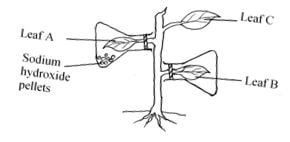
The potted plant was first de-starched by keeping it in dark for four days.
The set up was then placed in sunlight for five hours and leaves were tested for starch.- What scientific concept was being investigated? (1mk)
-
- Give the results likely to be obtained after starch test for A and B.
A and B.
A – (1mk)
B – (1mk) - Account for the results in leaf A in b (i) above. (1mk)
- Give the results likely to be obtained after starch test for A and B.
- Why was leaf C included in the set-up? (1mk)
- Give two reasons why primary productivity decreases with increase in depth in an aquatic ecosystem. (2 mks)
- Explain why certain drugs become ineffective in curing disease after many years of use. (2mks)
- Name two kidney diseases. (2mks)
- The diagram below represents a transverse section of an ovary from a certain flower.
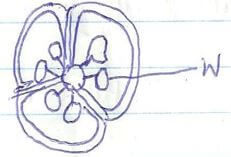
- Name the structure labelled W. (1mk)
- Name the type of placentation illustrated in this diagram. (1mk)
- Liver damage leads to impaired digestion of fats. Explain. (2marks)
-
- A person who is blood group AB has an advantage over a person who is blood group O. Explain. (2marks)
- Give two reasons for screening blood before transfusion. (2marks)

MARKING SCHEME
- Name the cell organelles which are abundant in (2 mks)
Muscle cells- mitochondria
Pancreas – Golgi bodies - Explain why the fine adjustment knob is used only when using high power objective lens. (1 mks)
To move small distances hence bringing an image into focus. - Distinguish between osmotic pressure and osmotic potential. (2mks)
Osmotic pressure is the tendency of a solution to take up water when separated from pure water by a semi-permeable membrane while osmotic potential is the tendency of water molecules to diffuse out of a solution. - Describe two adaptations of a leaf to the process of photosynthesis. (2mks)
Has chlorophyll, a pigment that traps light.
Has a large number of chloroplasts on the upper surface to increase the surface area for photosynthesis.
Thin layer of cuticle to allow penetration of light. - The diagram below illustrates part of a nephron from a mammalian kidney.
- Name the fluid in the part labelled Q. (1mk)
Glomerular filtrate - Identity the process responsible for the formation of the fluid named in (a) above. (1mk)
Ultra filtration - Which two hormones exert their effect in the nephron? (1mk)
Aldosterone
Anti diuretic hormone
- Name the fluid in the part labelled Q. (1mk)
-
- The figure below illustrates a portion of a chromosome with genes named A, B, C, S, Q and R.
Use the diagrams similar to the ones above to illustrate the changes if the above chromosome undergoes the following mutations affecting only gene C and S.- Deletion. (1mk)
A
B
Q
R
- Inversion. (1mk)
A
B
S
C
Q
R
- Deletion. (1mk)
- Human-inherited features can be grouped under two headings as follows.
What is the genetic explanation for the difference between the two groups? (2mks)- Group A shows continuous variation while group B shows discontinuous variation.
- The figure below illustrates a portion of a chromosome with genes named A, B, C, S, Q and R.
-
- Calculate the respiratory quotient of the oxidation reaction below. (2mks)
2C51H98O6 + 145O2 → 102CO2 + 98H2O + Energy
- RQ = amount of CO2 produced = 102 = 0.7
Amount of oxygen used 145
- RQ = amount of CO2 produced = 102 = 0.7
- Name the possible food being oxidised. (1 mks)
- Lipids/fats
- Calculate the respiratory quotient of the oxidation reaction below. (2mks)
- The wings of a bird and that of insects are analogous structures.
- What are analogous structures? (1 mark)
- These are structures with different embryonic origin but have been modified to perform similar functions.
- Name this type of evolution. (1 mark)
- Convergent evolution
- Name two vestigial structures found in man. (2 marks)
- Coccyx
- Appendix
- What are analogous structures? (1 mark)
- The diagram below represent the structure of a nerve cells.
-
- Identify the nerve cell. (1 mark)
- Motor neurone
- Give a reason for your answer in a (i) above. (1 mark)
- It has a cell body located at one end of the axon within the CNS. Its terminal dendrites terminate in the effectors.
- Identify the nerve cell. (1 mark)
- State the function of part labelled T. (1 mark)
- It fastens the transmission of nerve impulses
- Using an arrow show the direction of an impulse on the diagram. (1 mark)
-
- The diagram below represents a bone of a mammal.
- Identify the bone? (1 mark)
- Scapula
- Name the part marked X. (1 mark)
- Neural spine
- Name the bone that articulates at the part labelled F. (1 mark)
- Humerus
- State two adaptations of the bone to its function. (2 marks)
- It has a neural spine that provides large surface area for muscle attachment
- It has the glenoid cavity that articulates with the Humerus to form a ball and socket joint that rotates at 360 ͦ c
- Identify the bone? (1 mark)
- The diagram below shows a phenomenon which occurs during cell division.
- Identify the stage of cell division in which this phenomenon occurs. (1 mark)
- Prophase 1
- State the importance of the phenomenon taking place in the part labeled B. (2 marks)
- Recombination of genes; leading to variation
- Identify the stage of cell division in which this phenomenon occurs. (1 mark)
- Mutiso is unable to read history textbook held at arm’s length but read clearly at normal length.
- Identify the defect he is suffering from. (1 mark)
- Short sightedness.
- Why was he unable to read the book clearly at arm length? (1 mark)
- Long eye ball thus image formed before reaching retina.
- How can the defect be corrected? (1 mark)
- Wearing concave/diverging lens.
- Identify the defect he is suffering from. (1 mark)
- State two functions of blood in a human body. (2 marks)
- Regulation of the body temperature
- Regulation of pH of fluids
- Defence against disease – causing organism/ pathogens/ infection.
- State 3 significance of water in seed germination. (3 marks)
- Activate enzymes; provide a medium for enzymatic activities (to break down stored food to soluble form.
- Hydrolyses; dissolves food material;
- Is a medium of transportation of dissolved food substances to growing regions of radical and plumule
- Softens seed coat to facilitate emergence of radicle
- State two differences between complete and incomplete metamorphosis. (2 marks)
Complete metamorphosis
Incomplete metamorphosis
a) involves 4 series of changes i.e egg-larva-pupa-adult
a) involves 3 series of changes i.e egg-nymph-adult
b) growing stage in larva is different in form from adult form
b) growing state in nymph is similar to adult form
- The diagram below represents a fern.
- Name Parts labeled A and B. (2mk)
- A – Sori rej. sorus
- B – Rhizome
- To which division does the plant belong? (1mk)
- Pteridophyta
- Name Parts labeled A and B. (2mk)
-
- Define the term immunity. (1mk)
- Ability of the body to identify/ recognize foreign antigens and develop mechanisms of destroying them / ability to resist infection
- Distinguish between natural immunity and acquired immunity. (2mks)
- Natural immunity is inborn /inherited /passed from parents to offspring while acquired immunity is obtained in life
- Identify one immunizable disease in Kenya. (1mk)
- Tuberculosis; poliomyelitis; diphtheria; whooping cough; measles
- Define the term immunity. (1mk)
- The diagram below shows a stage during fertilization in flowering plant.
- Name the parts labeled Q, R, and S. (3 mks)
- Q – Antipodal cell(s)
- R – Polar nucleus / body
- S – Functional egg cell
- State the function of the pollen tube. (1mk)
- Pathway through which male nuclei reach the embryo sac / improves efficiency of fertilization; its tip produce lytic enzyme which dissolves the embryo sac wall to allow entry of male nuclei
- Name the parts labeled Q, R, and S. (3 mks)
-
- State the major cause of the ‘Global warming’ experienced in the world today. (1mk)
- Carbon (IV) Oxide; rej. Carbon (iv) Oxide
- Suggest two ways of reducing the Global warming. (2mks)
- Reducing use wood / fossil fuels; planting more trees / afforestation or re-afforestation
- State the major cause of the ‘Global warming’ experienced in the world today. (1mk)
- An experiment was set to investigate a certain aspect of response. A seedling was put on a horizontal position as shown in figure M below. After 24 hours, the set up was as shown in figure N.
- Name the response exhibited. (1mk)
- Geotropism
- Explain the curvature of the shoot upwards. (3mk)
- Gravity causes high concentration of auxins on the lower part of the shoot; this causes faster elongation of cells on the lower part compared to the upper part; making the shoot to curve upwards
- Name the response exhibited. (1mk)
- The diagram below represents an experimental set up to investigate a certain scientific concept. The potted plant was first de-starched by keeping it in dark for four days.
The set up was then placed in sunlight for five hours and leaves were tested for starch.- What scientific concept was being investigated? (1mk)
- Photosynthesis
-
- Give the results likely to be obtained after starch test for A and B.
- A and B.
- A – Negative test / starch absent (1mk)
- B – Positive test / starch present (1mk)
- Account for the results in leaf A in b (i) above. (1mk)
- Sodium hydroxide absorbed all the Carbon (IV) Oxide hence no photosynthesis
- Why was leaf C included in the set-up? (1mk)
- Control experiment
- Give the results likely to be obtained after starch test for A and B.
- What scientific concept was being investigated? (1mk)
- Give two reasons why primary productivity decreases with increase in depth in an aquatic ecosystem. (2 marks)
- Decrease in light intensity hence low photosynthesis.
- Decrease in oxygen for respiration.
- Explain why certain drugs become ineffective in curing disease after many years of use. (2mks)
- Disease causing organism mutate; and become resistant
- Name two kidney diseases. (2mks)
- Nephritis
- Kidney stones
- The diagram below represents a transverse section of an ovary from a certain flower.
- Name the structure labelled W. (1mk)
- ovule
- Name the type of placentation illustrated in this diagram. (1mk)
- axile
- Name the structure labelled W. (1mk)
- Liver damage leads to impaired digestion of fats. Explain. (2marks)
- No production of bile to emulsify fats.
-
- A person who is blood group AB has an advantage over a person who is blood group O. Explain. (2marks)
- Shall be a universal recipient ; can receive blood from any blood group ; while a person with blood group ‘O’ can only receive blood from a person with blood group O/ AB has no antibodies while O has no antigen
- Give two reasons for screening blood before transfusion. (2marks)
- To check for compatibility
- To make sure the blood is free from diseases (such as HIV, Hepatitis B)
- A person who is blood group AB has an advantage over a person who is blood group O. Explain. (2marks)
Download Biology Paper 1 Questions and Answers - Form 4 Term 2 Opener Exams 2023.
Tap Here to Download for 50/-
Get on WhatsApp for 50/-
Why download?
- ✔ To read offline at any time.
- ✔ To Print at your convenience
- ✔ Share Easily with Friends / Students

